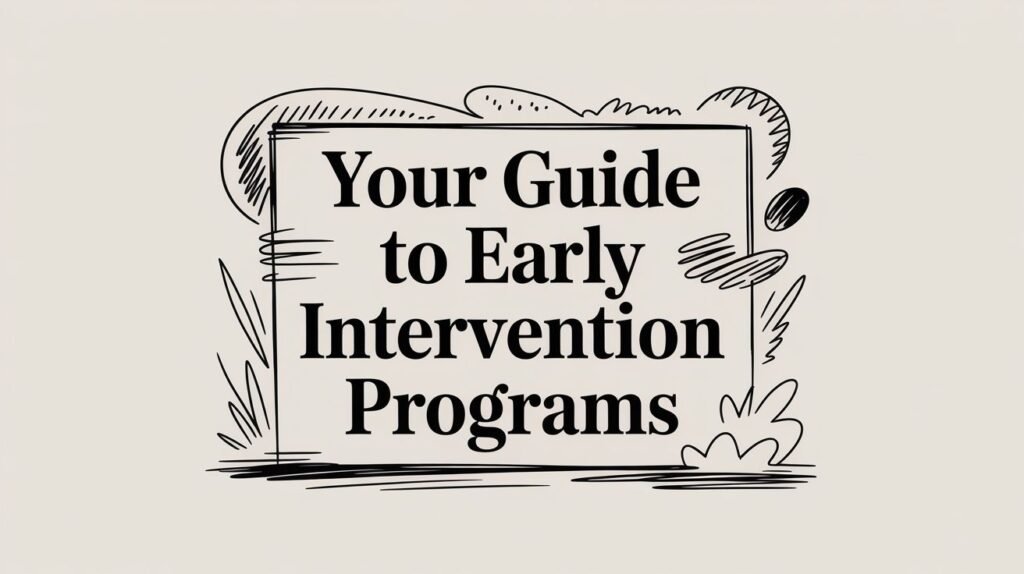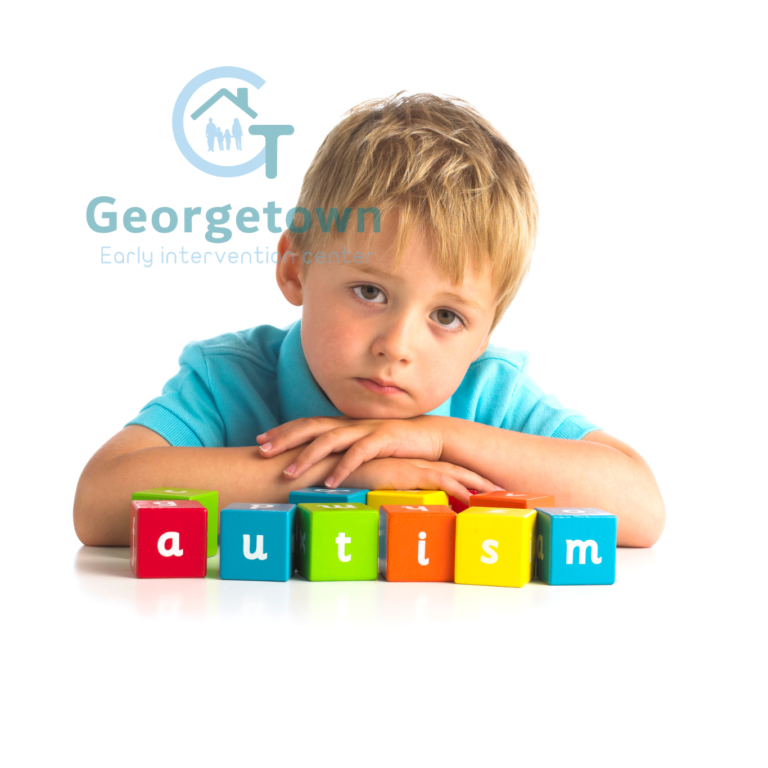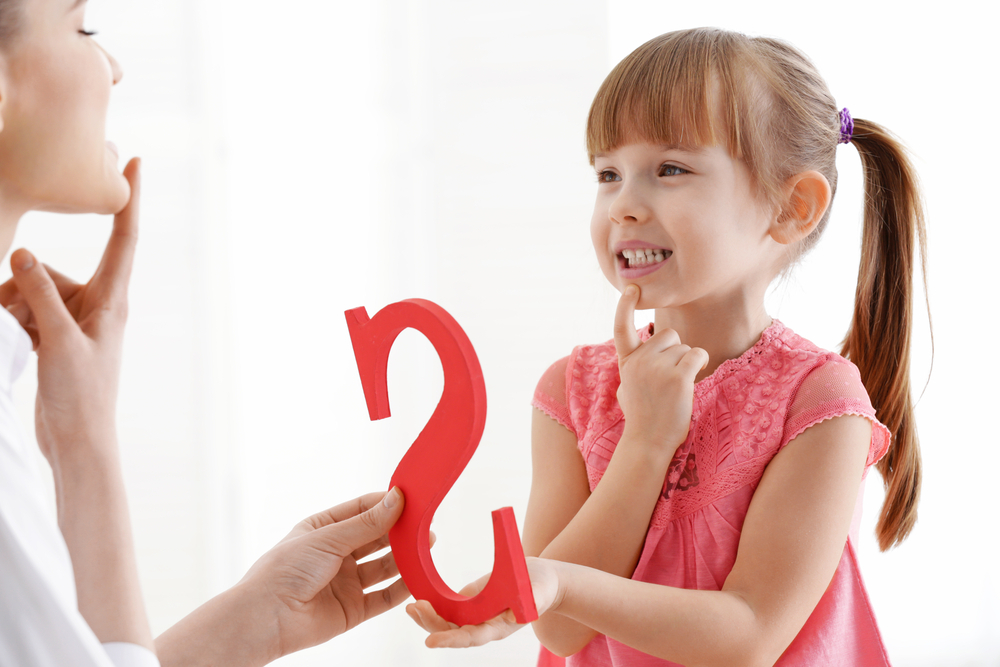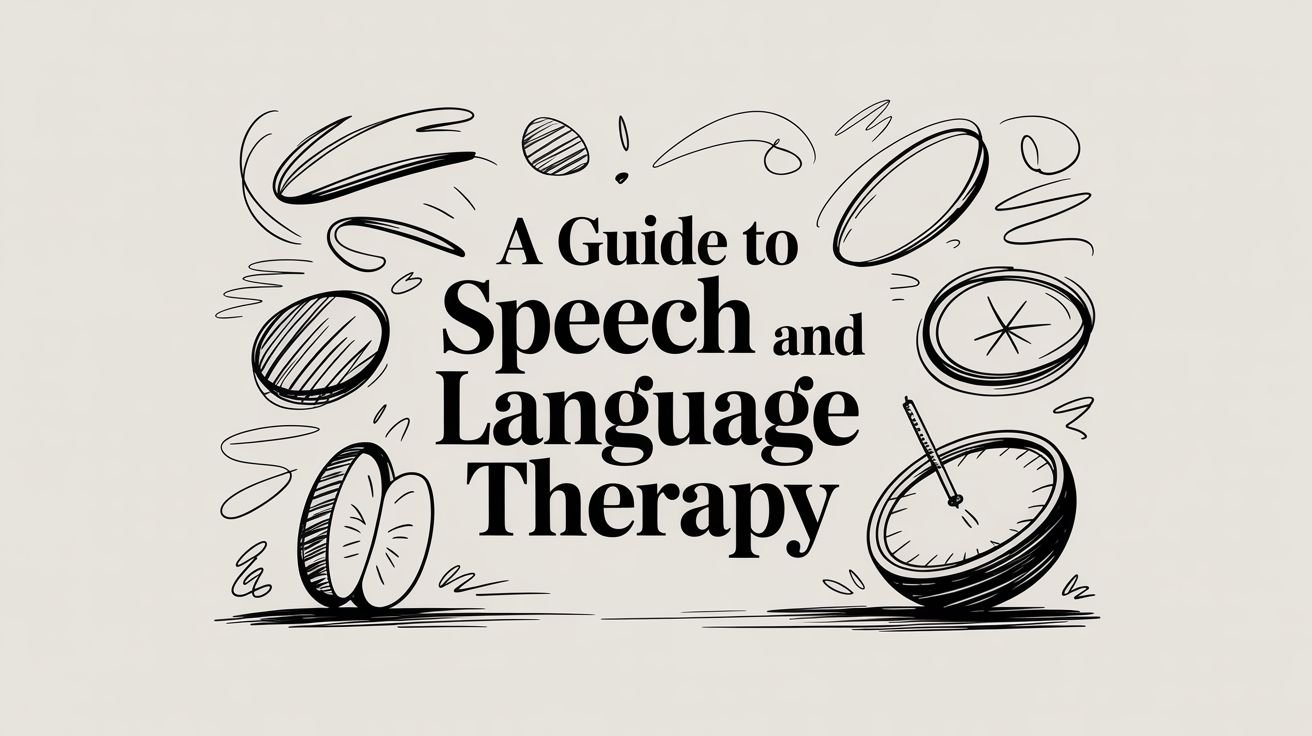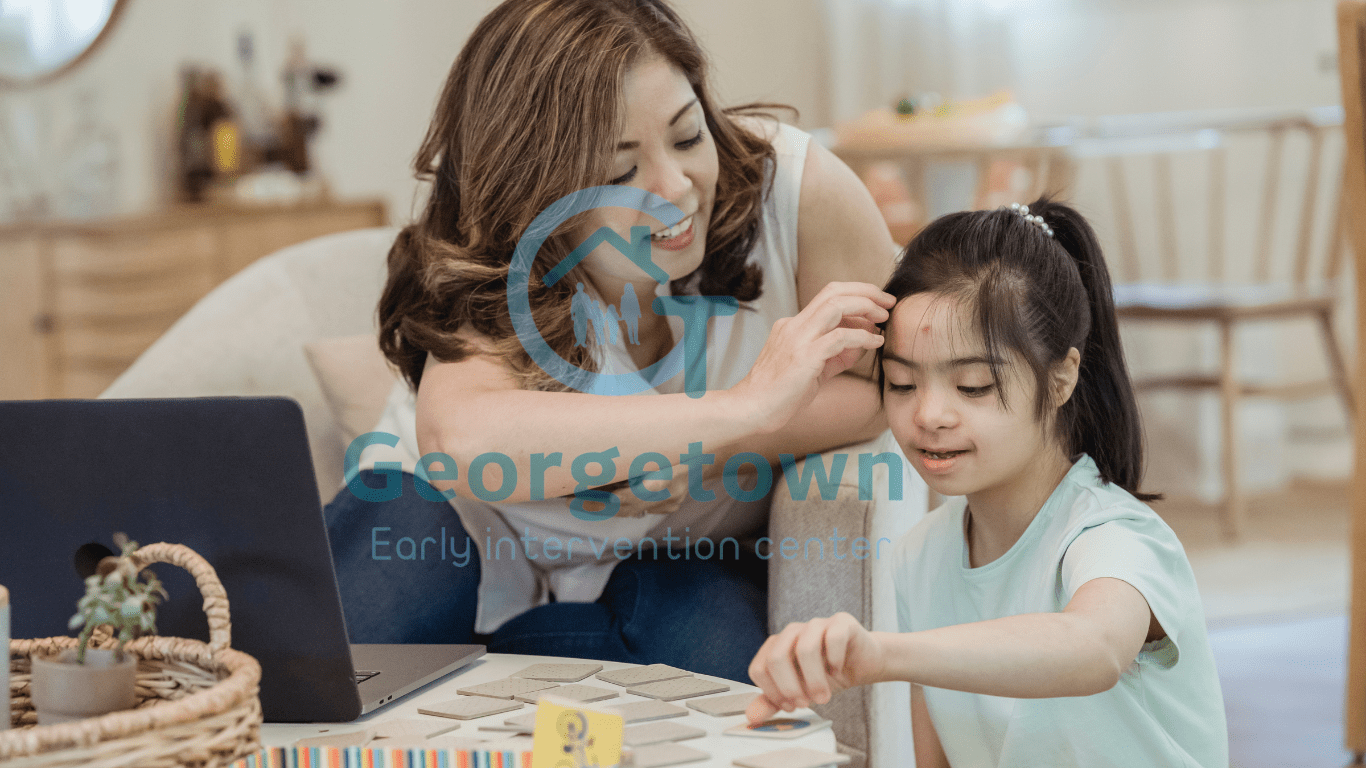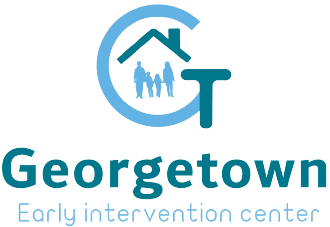An early intervention program is essentially a support system for infants and toddlers, from birth up to age three, who might be experiencing developmental delays or have a diagnosed disability.
Think of it like this: you're giving a young plant the perfect soil, just the right amount of light, and the water it needs to flourish. It’s not about "fixing" a problem. It’s about nurturing a child’s incredible potential and building a solid foundation for all their future learning and growth.
Understanding the Purpose of Early Intervention

At its heart, early intervention is a proactive, family-focused way of looking at child development. It’s all built on one powerful, simple truth: the first three years of a child's life are a time of explosive brain development. When we address developmental concerns during this critical window, we can make a massive and lasting difference.
These programs aren’t just for the child, though. They are designed to wrap around the entire family. The main goal is to give parents and caregivers the strategies, knowledge, and confidence they need to support their child's development in everyday moments. This turns the home into the most important place for learning and growth to happen.
Who Benefits from These Programs
An early intervention program is for any infant or toddler who shows signs of a delay in one or more key areas of development. The services are always customized to what each child and family needs, making sure they get the right support at exactly the right time.
Our teams often focus on a few key areas:
- Cognitive Skills: This covers how a child thinks, learns, and solves problems.
- Physical Development: We look at everything from reaching and crawling to walking and fine motor skills, like picking up a small toy.
- Communication Skills: This includes babbling, talking, listening, and understanding what others are saying.
- Social or Emotional Skills: This is all about playing, getting along with others, and expressing big feelings.
- Adaptive Development: These are the practical self-help skills, like feeding and dressing themselves.
"The goal is to reassure you that seeking support early is a powerful, proactive step toward building a strong foundation for your child's future, making the concept feel accessible and empowering rather than clinical or intimidating."
How Early Intervention Works in Practice
There's no one-size-fits-all model here. Instead, every service is completely individualized. A team of specialists—which might include speech therapists, occupational therapists, and educational psychologists—will work directly with your family to create a unique support plan. You can learn more about the importance of early intervention in child development and how it truly sets the stage for future success.
The real magic is in weaving therapeutic activities right into your daily routines. For example, a speech therapist might show you how to use bath time to encourage new sounds, instantly turning a simple daily task into a fun learning opportunity. This practical approach helps children build essential skills in a way that feels natural and comfortable.
Many of these initiatives are made possible through vital funding sources like federal grants for autism programs, which underscores the commitment to providing specialized care where it's needed most. By empowering families and using a child's own environment, these programs help create progress that is both meaningful and sustainable.
Recognizing Important Developmental Milestones
As a parent, you are the world’s foremost expert on your child. You know their quirks, their personality, and that special way their face lights up. But in the whirlwind of day-to-day life, keeping track of their development can feel a bit overwhelming. This guide is here to help you make sense of the key developmental milestones you can expect to see from birth to age three.
We’ll look at these stages not as a rigid checklist, but through real-world examples—like the pure joy of a first wave goodbye or the sheer determination behind learning to crawl. Every child’s journey is different, and they will absolutely grow at their own pace. Still, understanding the typical age ranges can empower you to spot when a potential delay might be worth discussing with a professional.
Your Child’s Developmental Journey
A child's first few years are an explosion of growth across four main areas. Think of them as interconnected building blocks; when a child makes progress in one area, it often boosts their development in another. The first step is getting familiar with the major baby milestones that lay the foundation for all future learning.
- Communication Skills: This starts with those first sweet coos and babbles and eventually blossoms into first words and simple sentences. It also includes non-verbal cues, like pointing with purpose to show you exactly what they want.
- Motor Skills: This category covers both big movements (gross motor) like rolling over, sitting up, and walking, as well as the smaller, more precise ones (fine motor) like grasping a toy or learning to feed themselves.
- Cognitive Skills: This is all about how your child learns, thinks, and solves problems. It includes being curious, recognizing familiar faces, and understanding cause and effect—like knowing that shaking a rattle makes a fun sound.
- Social-Emotional Skills: This involves how your child connects with others and starts to manage their big feelings. Milestones here include that first social smile, showing affection, and learning to play alongside other children.
Identifying When to Seek Support
While milestones provide a useful map, they aren’t a strict timetable. It’s perfectly normal for a child to be a little ahead in motor skills but a bit behind in language, for instance. What’s important is to look at the overall picture of their development.
If you notice a consistent pattern of missed milestones, or if your child seems to lose skills they once had, it could be a sign to seek guidance. For a deeper look into this topic, you might find our guide on https://georgetownuae.com/what-is-development-delay-what-causes-development-delay/ helpful.
Connecting families with an early intervention program is critical, but unfortunately, access isn't always straightforward. For example, in California during 2018-2019, only 5.41% of children from birth to age 3 were able to access the state's Early Start services. Screening rates were also inconsistent, with some areas reporting numbers as low as 3.51%. This highlights just how crucial parental awareness truly is.
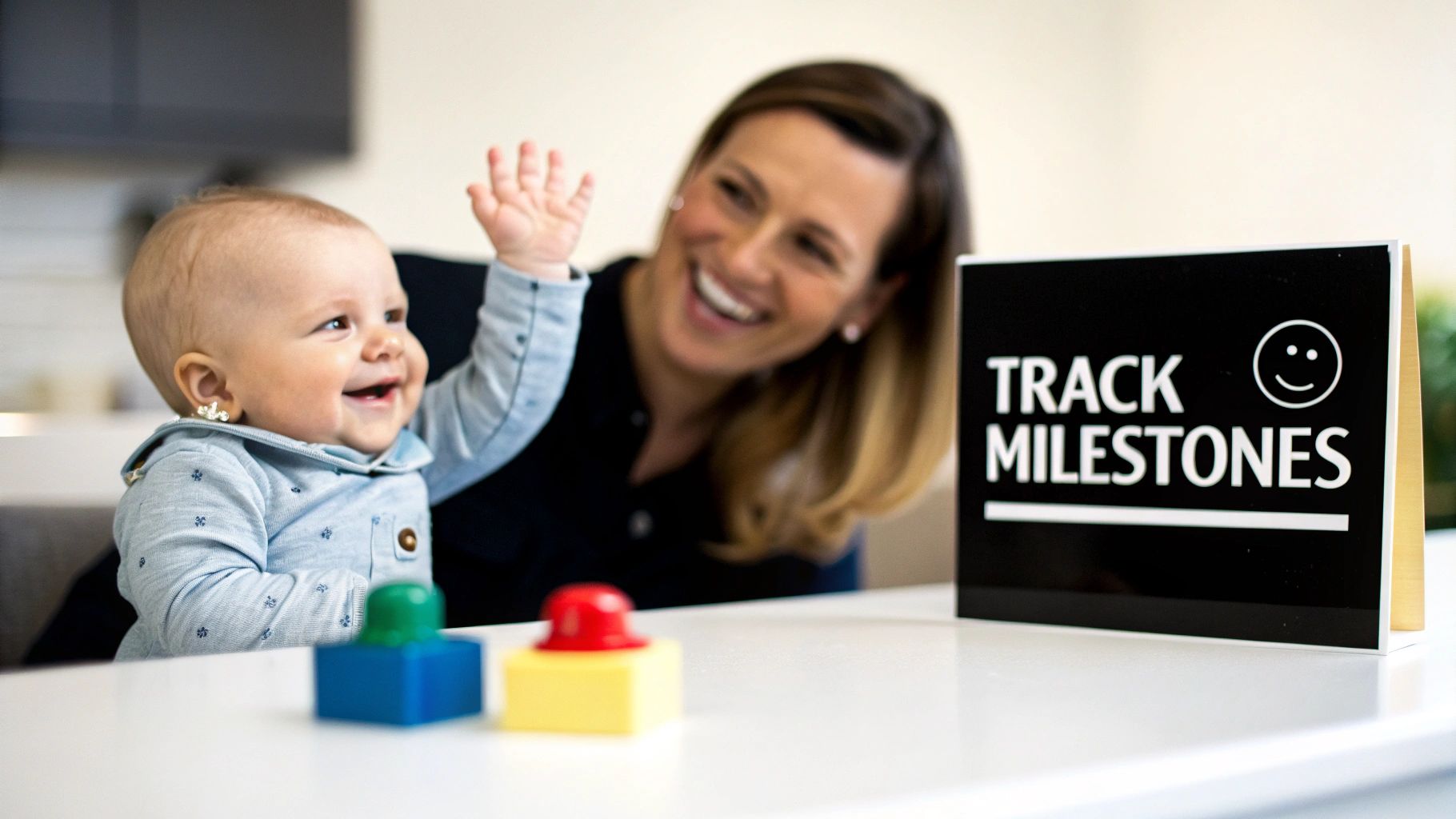
Your observations as a parent are incredibly valuable. Trusting your intuition and speaking up if you have concerns is one of the most powerful actions you can take to support your child's well-being.
A Snapshot of Key Milestones
Here’s a quick-reference table to give you an idea of what you might see as your child grows. Just remember, these are general timelines, and slight variations are completely normal and expected.
Key Developmental Milestones from Birth to Age 3
| Age Range | Communication Skills | Motor Skills | Social/Emotional Skills |
|---|---|---|---|
| By 6 Months | Responds to sounds by making sounds, strings vowels together ("ah," "eh," "oh"), laughs. | Rolls over in both directions, begins to sit without support, supports weight on legs when standing. | Knows familiar faces, likes to play with others (especially parents), responds to others' emotions. |
| By 1 Year | Uses simple gestures like waving "bye-bye," says "mama" and "dada," tries to say words you say. | Pulls up to stand, may take a few steps holding on ("cruising"), may stand alone. | Is shy with strangers, has favorite toys and people, shows fear in some situations. |
| By 2 Years | Says sentences with 2 to 4 words, points to things when named, knows names of familiar people. | Kicks a ball, begins to run, walks up and down stairs holding on, throws a ball overhand. | Gets excited when with other children, shows more independence, shows defiant behavior. |
| By 3 Years | Follows instructions with 2 or 3 steps, can name most familiar things, says first name, age, and gender. | Climbs well, runs easily, pedals a tricycle, walks up and down stairs one foot per step. | Shows a wide range of emotions, separates easily from parents, shows affection for friends. |
Ultimately, recognizing milestones is about being an informed and engaged observer in your child’s life. Your unique insight, combined with this knowledge, makes you the best possible advocate for their developmental journey.
The Core Therapies That Support Your Child
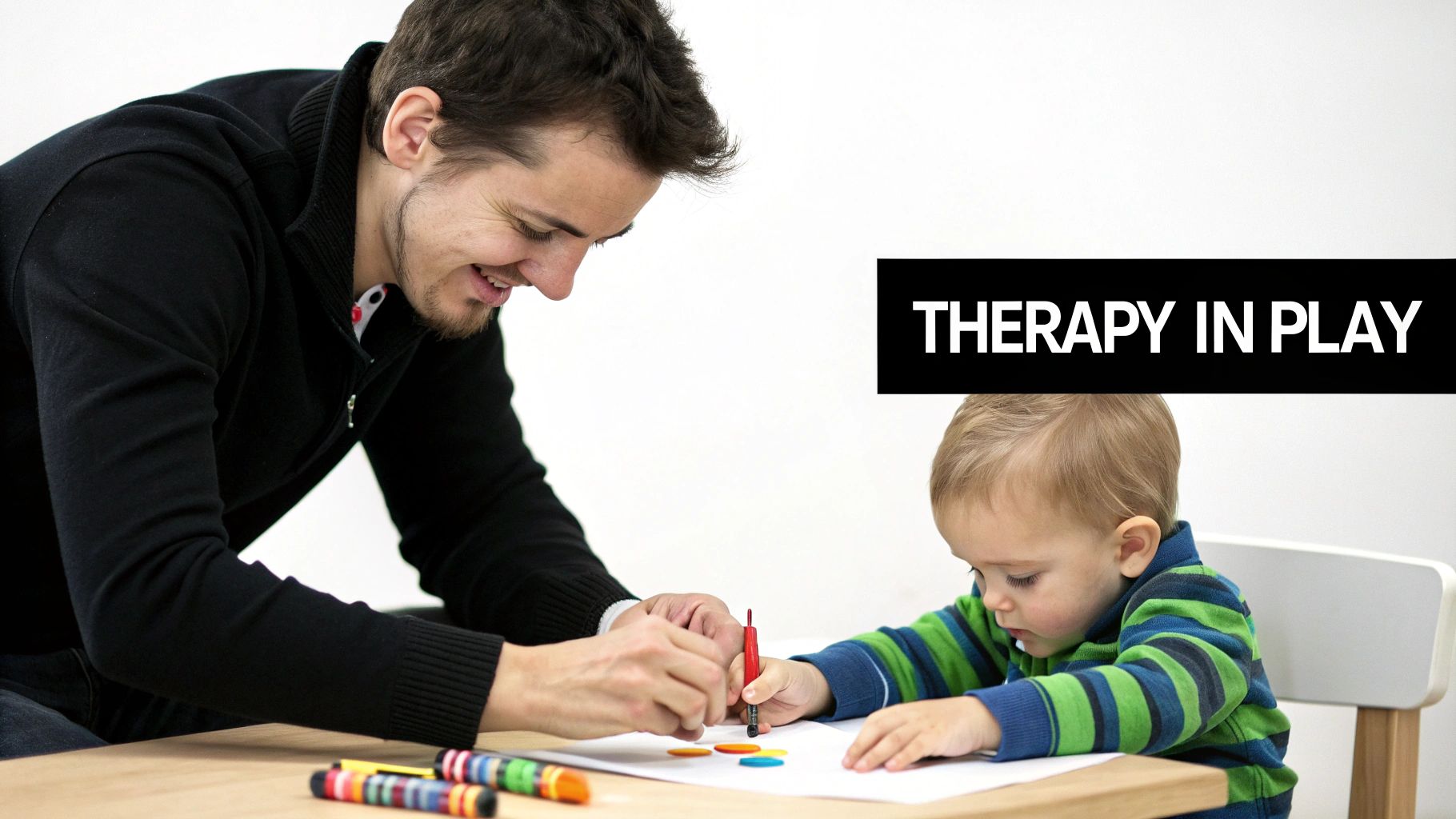
So, what does “therapy” actually look like for a toddler or preschooler? The word might bring to mind a formal, clinical office, but in an early intervention program, it’s all about purposeful play. Our therapists are experts at weaving skill-building into fun, engaging activities that just feel like playtime to your child.
While each type of therapy has its own special focus, they all share one big goal: to help your child build the foundational skills they need to explore their world with confidence. These therapies work together, creating a supportive web that addresses your child’s specific needs from every angle.
Let's dive into the most common types of support you’ll find.
Speech And Language Therapy
Speech therapy is usually the first thing that comes to mind for parents, and for good reason. It’s about so much more than just making sounds—it's about the entire world of communication. A speech therapist helps children understand what others are saying (receptive language) and express their own thoughts, needs, and feelings (expressive language).
Imagine a session where the therapist and your child are playing with toy animals. As they play, the therapist models sounds ("moo," "baa") and simple words ("cow," "in," "out"). This play-based approach turns learning into a game, encouraging your child to imitate sounds and words in a fun, low-pressure way.
It’s important to remember that communication is a two-way street. Therapists don't just focus on talking; they also help with listening skills, understanding directions, and using gestures like pointing and waving to get a message across.
Occupational Therapy
When you hear "occupation," you probably think of a job. For a child, their most important job is to play, learn, and grow! Occupational therapy (OT) helps children develop the skills they need for the everyday tasks—or "occupations"—of childhood. This can be anything from self-care routines to participating in activities at home and preschool.
An OT session might look like they're just having fun with Play-Doh, but the real goal is to strengthen the small muscles in the hands (fine motor skills) needed to eventually hold a crayon or use a spoon. Or, it could involve navigating a mini obstacle course to improve balance and body awareness (gross motor skills).
OT often helps with:
- Fine Motor Skills: Grasping toys, stacking blocks, and using utensils.
- Sensory Processing: Helping a child manage their responses to sensory input, like loud noises or certain textures.
- Self-Help Skills: Learning to get dressed, brush teeth, and feed themselves.
By building these practical skills, occupational therapy empowers children to become more independent and successfully engage with the world around them.
Applied Behaviour Analysis
Applied Behaviour Analysis (ABA) is another specialized support that focuses on understanding and improving behavior. It’s a highly individualized approach that uses positive reinforcement to teach new skills and reduce challenging behaviors. While ABA is often associated with support for children with autism, its use in early intervention programs has grown significantly.
For instance, data from the United States shows a notable increase in participation for children with autism spectrum disorder. Between those born in 1998 and 2008, enrollment in an early intervention program climbed from 39.3% to 55.5%. This shift reflects a growing understanding of how beneficial it is to start these supports early.
In practice, an ABA session might involve breaking down a complex skill, like asking for a toy, into small, manageable steps. The therapist might first teach the child to point to the toy, then to make a sound, and finally to say the word, celebrating each success along the way with praise or a favorite activity.
The goal of ABA is to help children learn socially important behaviors in a structured and supportive way. As you explore your options, you might be interested in exploring three common strategies of therapy used in early intervention. These therapies often work together beautifully, providing a well-rounded support system that helps your child thrive.
Creating Your Family's Support Blueprint
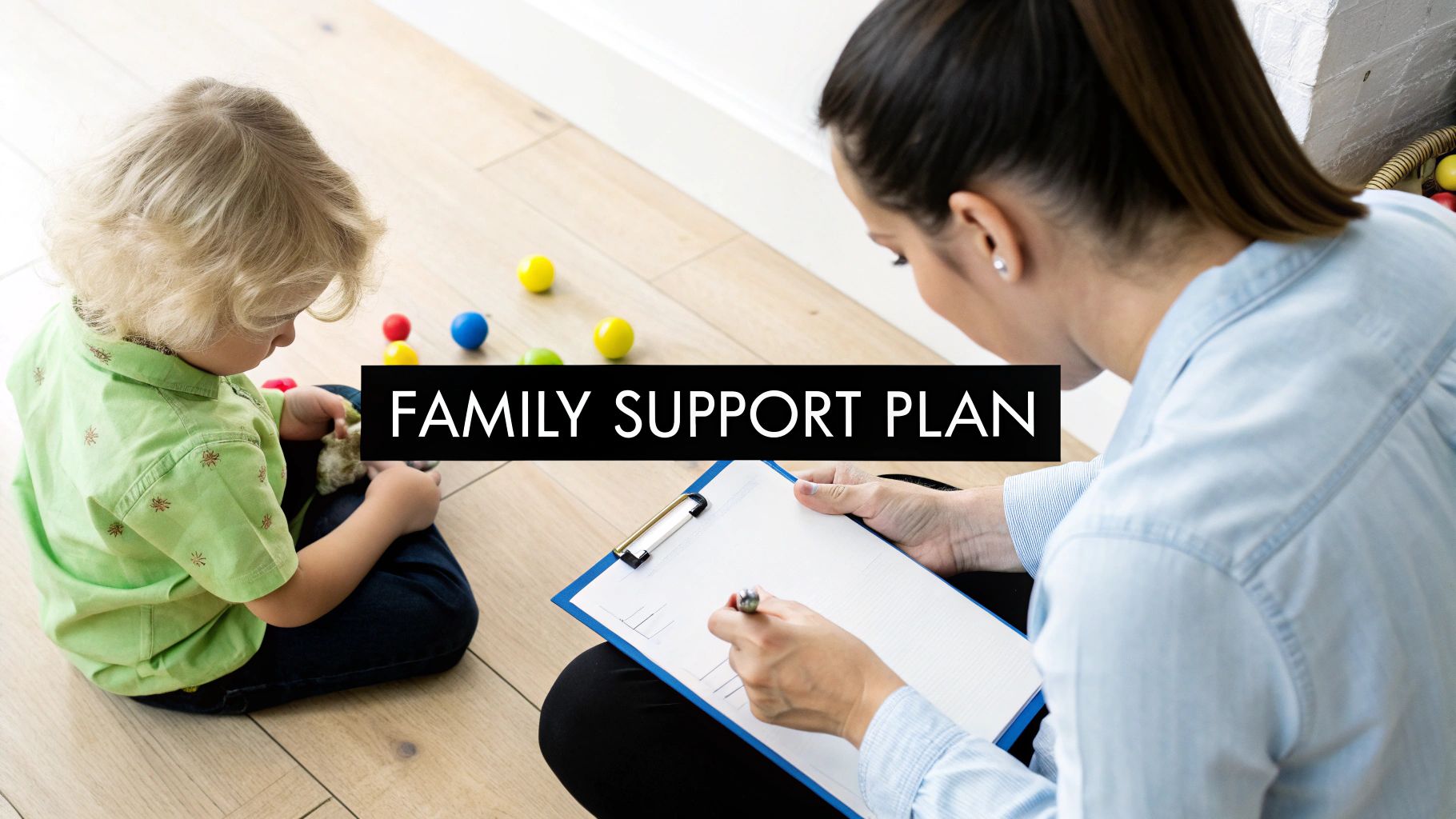
Once the initial evaluations are complete, we get to the heart of your early intervention program journey: creating a plan. This isn't some rigid, top-down document that gets handed to you. Far from it. It's a collaborative, living blueprint we call the Individualized Family Service Plan (IFSP).
Think of the IFSP as a personalized roadmap. It doesn't just zoom in on your child; it's designed to support your entire family. This plan is built with you, not for you, making sure your family’s unique strengths, concerns, and priorities are right at the center of every decision.
Your role in this process is absolutely essential. You're the expert on your child, and your insights are the most valuable tool we have for creating a plan that truly works.
What Is An IFSP?
The IFSP is a written plan that maps out the specific services and support your child and family will receive. It's a dynamic guide that evolves as your child grows and hits new milestones. Its main job is to create a clear path for achieving the goals you set together with your therapy team.
But this document is so much more than a list of therapies. It's a comprehensive overview that captures a complete picture of your child's development and your family's hopes for the future.
The core components of the IFSP include:
- Present Levels of Development: This is a detailed summary of your child’s current abilities across all developmental areas—cognitive, motor, communication, social-emotional, and adaptive skills. It’s our starting point.
- Family Resources and Priorities: A section dedicated entirely to your family's strengths, needs, and concerns. This ensures the plan respects and fits into your family’s values and daily life.
- Measurable Goals and Outcomes: These are concrete, achievable goals for both your child and your family. For example, a goal might be for your child to use three new words to ask for what they want, or for you to feel more confident using new communication strategies at home.
- Specific Services: Here, we'll clearly outline the services to be provided. This includes the type (like speech therapy), frequency, intensity, and location (at home or at our center).
This collaborative approach ensures every part of the early intervention program is perfectly suited to your unique situation, making the support both meaningful and effective.
The IFSP is fundamentally a promise—a promise that your family’s voice will guide every step of the process. It transforms your hopes and concerns into a concrete, actionable plan for success.
Your Role As An Equal Partner
Let's be clear: you are the most important member of your child’s IFSP team. Your active participation is what turns this document into a truly powerful tool. You bring a deep understanding of your child's personality, preferences, and daily routines that no professional can ever replicate.
To be an effective partner in this process, here are a few things to keep in mind:
- Share Your Insights: Come ready to talk about your child's strengths and challenges. What makes them light up? What frustrates them? What are your biggest hopes for them over the next six months?
- Ask Questions: Never hesitate to ask for clarification on anything you don't understand. If a term is unfamiliar or a goal seems unclear, please speak up. This is your plan, and you should feel completely comfortable with every part of it.
- Define Your Family's Goals: Think about what you want to achieve as a family. Maybe you want to have less stressful mealtimes or find better ways to navigate tantrums. These family-focused goals are just as important as your child's developmental milestones.
By being an active participant, you ensure the IFSP is a practical guide that fits seamlessly into your life, turning everyday moments into opportunities for growth and connection.
Taking the First Step: How Enrollment Works
Deciding to explore an early intervention program can feel like a huge step, and maybe even a little overwhelming. From the outside, the process can look complicated, but it's really a clear, structured path designed to get your child the right support as quickly and smoothly as possible. Let’s walk through the enrollment journey together, breaking down each stage into simple, understandable actions.
Our goal here is to pull back the curtain on the process, ease any worries you might have, and help you feel confident moving forward. When you know what’s coming next, the whole experience feels much more manageable. Remember, from the first phone call to the final planning meeting, you are the most important member of your child's team.
Making the Initial Referral
It all starts with a referral. This is just the official way of asking for your child to be evaluated for an early intervention program. The best part about this first step? It can be started by just about anyone who has a concern about a child’s development.
Who can make a referral?
- Parents or Guardians: You know your child better than anyone. If you have concerns, you can and should request an evaluation.
- Doctors or Pediatricians: It’s common for a child’s doctor to recommend an evaluation, often after a routine developmental screening.
- Childcare Providers or Teachers: The professionals who see your child every day might also suggest a referral if they notice potential delays.
Once the referral is made, a service coordinator will be assigned to your family. Think of this person as your personal guide—they’ll explain the next steps, answer all your questions, and help you get everything scheduled. They are your go-to person and support system through the whole process.
The Multidisciplinary Evaluation
After the referral, the next step is a comprehensive evaluation. This isn't a test for your child to pass or fail. It’s simply a way for a team of specialists to get a complete picture of your child’s unique strengths and the areas where they might need a little extra help. The evaluation is always done in a comfortable, play-based way.
The team usually includes a few different professionals, like:
- An educational psychologist
- A speech and language therapist
- An occupational or physical therapist
Each expert will play and interact with your child, observing their skills in areas like communication, motor abilities, learning, and social play. Your input here is absolutely essential. You’ll be asked about your child’s daily routines, what you see at home, and what your biggest concerns are. This teamwork ensures the specialists see your child through your eyes, too.
The evaluation is a holistic look at your child's world. Its purpose is to identify specific needs so that a truly individualized plan can be created to help them thrive.
Determining Eligibility and Planning What’s Next
Once the evaluation is complete, the team will sit down with you to go over their findings and determine if your child is eligible for services. Eligibility is usually based on whether a child has a certain level of developmental delay in one or more areas, or if they have a diagnosed condition that is known to affect development.
It’s worth noting that access to these vital services isn't always straightforward for everyone. A 2021 report on early intervention services revealed some real disparities, especially at the referral and evaluation stages. For example, evaluation rates after a referral ranged from just 59% for some groups to 86% for others, which shows there are still systemic gaps we need to close. To dive deeper into these findings, you can learn more about the IDEA early intervention programs.
If your child is found eligible, the team will work with you to create an Individualized Family Service Plan (IFSP). This document becomes the blueprint for all the support your child and family will receive from the early intervention program. If your child isn't found eligible, the team won’t leave you hanging—they'll provide other community resources and suggestions. No matter the outcome, you’ll walk away with a clearer understanding of your child’s development and a path forward.
Of course. Here is the rewritten section, crafted to sound completely human-written, following the style of the provided examples.
Your Questions, Answered
Stepping into the world of early intervention can feel like navigating a new map. It's completely normal to have questions and even a few worries. We get it. We've sat down with countless parents who were in the exact same spot you are now.
To help put your mind at ease, we’ve gathered some of the most common questions we hear. Our goal is to give you clear, straightforward answers so you can feel confident and empowered. This isn't a journey of anxiety; it's a positive, proactive step you're taking for your child and your family.
How Much Will This Cost My Family?
This is almost always the first thing parents ask, and for good reason. The financial side of things matters. The good news is that many early intervention services are available at little to no cost to families. These programs are widely seen as essential for a child's development and are often supported by public funds.
Depending on where you live and your family's situation, services are typically funded through:
- Public health or educational initiatives
- Your private health insurance plan
- A sliding scale fee based on family income
Our service coordinators are pros at figuring this all out. They'll walk you through every option, help you understand your insurance coverage, and work to ensure cost never stands in the way of your child getting the support they deserve.
The core mission of any early intervention program is making sure every eligible child gets access to critical developmental support. The financial systems are designed to make that happen, regardless of a family's financial situation.
Will My Child Be Labeled?
The fear of a "label" is a heavy one. It’s natural to worry that a diagnosis or being in a special program will define your child in the eyes of others. But we encourage you to look at it from a different angle. Early intervention isn't about applying a label; it's about providing support.
Think of it this way: if your child struggled to see the board at school, you'd get them glasses. You wouldn't see the glasses as a label, but as a tool that helps them succeed. Early intervention is exactly the same. It’s a set of tools and strategies designed to help your child navigate their world with more ease and confidence. The focus is always on their strengths and what they can do.
What Is My Role During Therapy Sessions?
You have the most important role of all. You aren't just a spectator in therapy—you are our most essential partner. The skills learned in a session are most powerful when they're woven into your child's daily life, and you're the one who makes that happen.
Our therapists often act more like coaches. They'll show you how to turn everyday routines—like mealtime, bath time, or a trip to the park—into fun, skill-building opportunities. Your involvement ensures the learning doesn't stop when the session ends. You are, and always will be, your child’s first and best teacher. Our job is simply to support you in that role.

